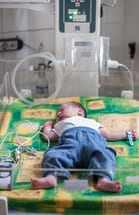Retinopathy of Prematurity
 Retinopathy of prematurity (ROP), also known as Terry syndrome or retrolental fibroplasia (RLF), is the abnormal growth of blood vessels and scar tissue on the retinas of a premature baby. The growth of these blood vessels can cause the retina to detach from the eye resulting in vision impairment or blindness. Retinal blood vessels are usually developed by the time of birth or shortly thereafter. A premature birth interrupts the development process resulting in the lack of oxygen and nutrients reaching the retina. As a result, blood vessels begin to grow abnormally to supplement the needs of the retina.
Retinopathy of prematurity (ROP), also known as Terry syndrome or retrolental fibroplasia (RLF), is the abnormal growth of blood vessels and scar tissue on the retinas of a premature baby. The growth of these blood vessels can cause the retina to detach from the eye resulting in vision impairment or blindness. Retinal blood vessels are usually developed by the time of birth or shortly thereafter. A premature birth interrupts the development process resulting in the lack of oxygen and nutrients reaching the retina. As a result, blood vessels begin to grow abnormally to supplement the needs of the retina.
Retinopathy of prematurity is one of the most common causes of childhood visual loss, and occurs most often in infants who weigh less than three pounds or who were born before the 31st week of pregnancy. Premature infants should be screened for ROP, as the condition sometimes does not present itself until several weeks after birth. If diagnosed, frequent monitoring is required to determine if the condition will resolve on its own or require treatment to reduce the risk of vision loss and other complications.
Risks Factors for Retinopathy of Prematurity
In addition to a premature birth, other risk factors for developing retinopathy of prematurity may include the following:
- Anemia
- Medication
- Oxygen levels
- Blood transfusion
- Difficulty breathing
- Respiratory distress
- Health
- Low birth weight
Stages of Retinopathy of Prematurity
The extent of abnormal blood vessel growth is categorized into five stages, based on the patient's condition. Most of the infants diagnosed with ROP are diagnosed with mild cases, which includes some abnormal vessel growth but does not tend to cause permanent damage. More severe cases that involve significant growth of abnormal blood vessels may lead to retinal detachment and eventually cause vision loss or even blindness.
The stages of retinopathy of prematurity are classified as follows:
Stage I: Mild, abnormal blood vessel growth. The disease usually resolves on its own without further treatment.
Stage II: Moderate, abnormal blood vessel growth. The disease usually resolves on its own without further treatment.
Stage III: Severely, abnormal blood vessel growth. The disease can resolve on its own but may require treatment depending on the degree of severity of the disease.
Stage IV: Severely abnormal blood vessel growth and a retina that is partially detached that requires treatment.
Stage V: The retina is completely detached and requires treatment to avoid total loss of vision.
Symptoms of Retinopathy of Prematurity
Visual symptoms of retinopathy of prematurity may include:
- Abnormal movement of the eyes
- Strabismus, or crossed eyes
- Myopia, or nearsightedness
- Pupils that are white
Complications of Retinopathy of Prematurity
Retinopathy of prematurity can lead to a higher risk of developing the following conditions later on in life:
- Retinal detachment
- Myopia, or nearsightedness
- Strabismus, or crossed eyes
- Amblyopia, or lazy eye
- Glaucoma
- Blindness
Treatment of Retinopathy of Prematurity
In its early stages, many cases of retinopathy of prematurity do not require treatment. If the condition is advanced, laser therapy and cryotherapy are most often effective in destroying the peripheral areas of the retina to slow or reverse the growth of abnormal blood vessels. Laser treatments are used to burn away the periphery of the retina, while cryotherapy uses extremely cold temperatures to freeze the periphery. The side effects of either procedure includes a loss of peripheral vision, or side vision.
Additional treatment options for the advanced stages of ROP may include:
- Scleral buckle procedure
- Vitrectomy
Both of these surgical procedures may involve long-term side effects. Regular monitoring will also be performed to reduce the risk of vision loss and ensure that the patient's eyes remain healthy and develop normally.

